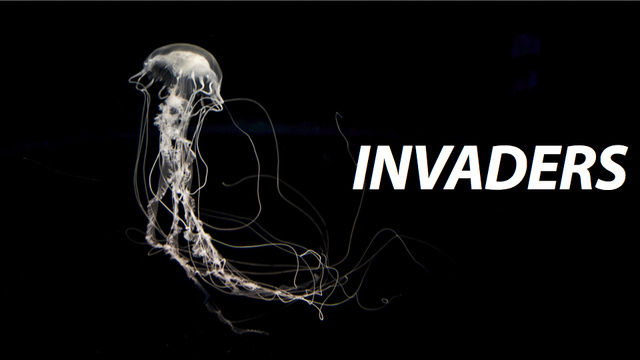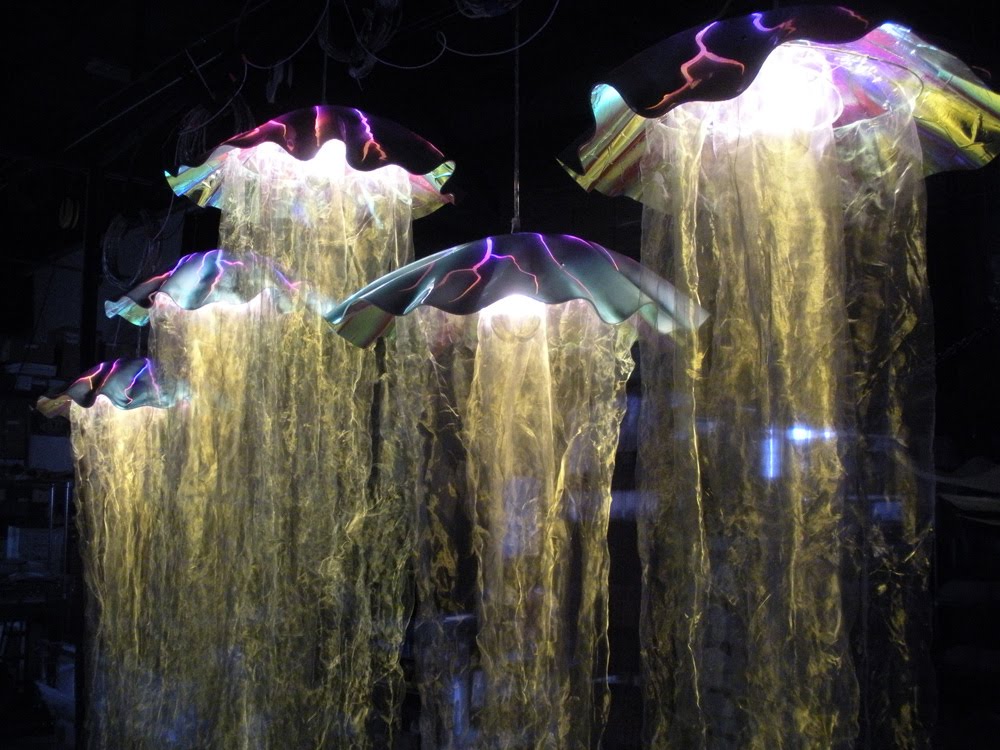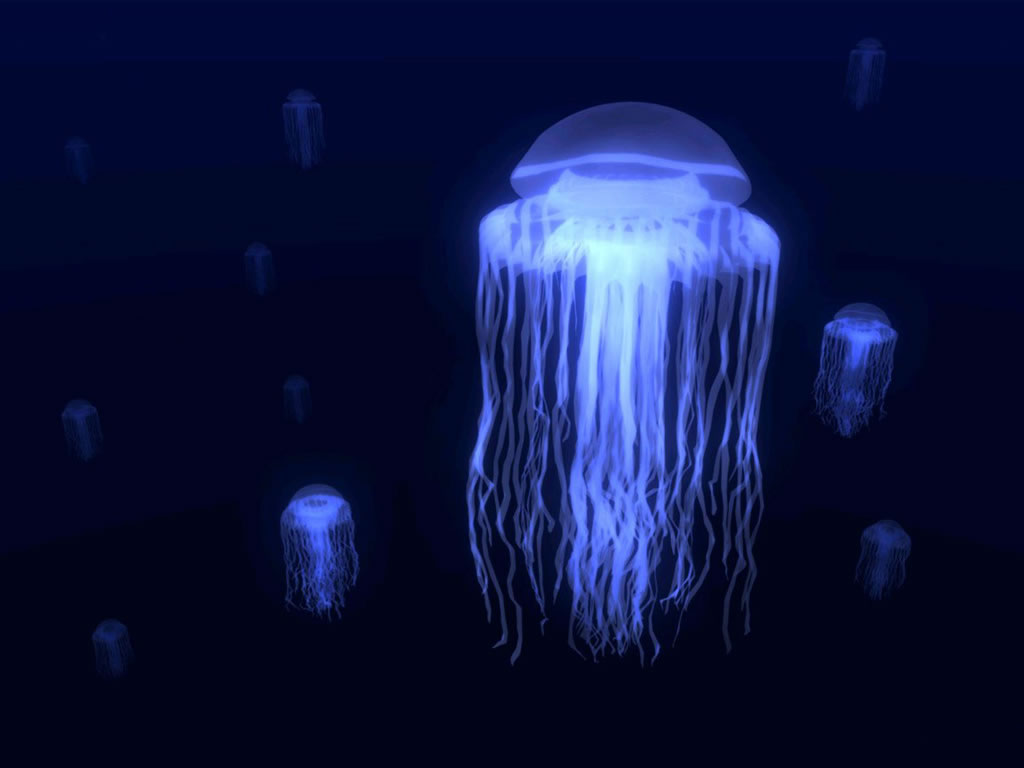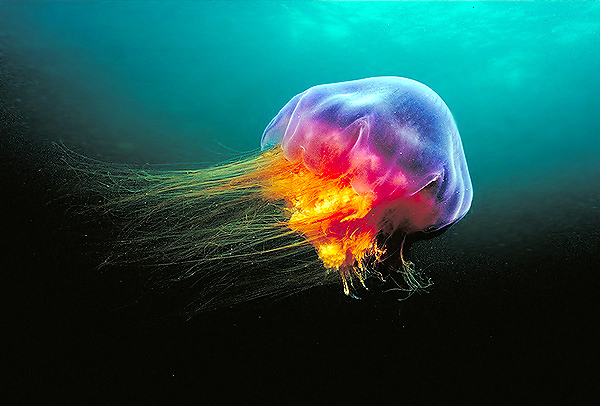It looks like you're using an Ad Blocker.
Please white-list or disable AboveTopSecret.com in your ad-blocking tool.
Thank you.
Some features of ATS will be disabled while you continue to use an ad-blocker.
share:

Is mother nature fighting back saying no to nuclear power?
The Los Angeles Times reports that the weird, gooey beasts, called salp, usually stay far off the coasts, but for some unknown reason they've migrated to the Diablo Canyon plant in San Luis Obispo. The plants operator, PG&E has been forced to cut production because of the event:
Workers on Monday discovered an influx of the creatures, called salp, clogging screens that are used to keep marine life out of the seawater used as a coolant, Cuddy said. Often thronging many square miles of ocean in huge, gelatinous masses, salp are tubular, transparent organisms that can be roughly the size of a human thumb. No one knows how many are at the Avila Beach plant or how long they will remain.
The creatures aren't each that big—there are just too many of them. According to officials, the salp will likely disperse after a few days. Apparently it's not that weird for jellyfish to swarm power plants. It's just that no one seems to have a good explanation.
They pose no threat you say? Surrrrrrrrrrre they don't.
Gizmodo
Apparently its not weird for them to swarm power plants? Really???
Maybe mother nature is just pissed that we are pouring radioactivity into the ocean from places like Fukashima...
Guess it's time for the arbitrary Godzilla reference:

reply to post by pianopraze
I will back them up on that statement - i have seen various reports over the years of jellyfish (and other invertebrates such as octopus) swarming power plants (and not always nuclear power either).
Those reports also showed scientists didn't have a clue why this happened.
A natural world puzzler - good, not enough mysteries left in my opinion!
I will back them up on that statement - i have seen various reports over the years of jellyfish (and other invertebrates such as octopus) swarming power plants (and not always nuclear power either).
Those reports also showed scientists didn't have a clue why this happened.
A natural world puzzler - good, not enough mysteries left in my opinion!
reply to post by Flavian
apparently so...
link
Marine Biologist reason: over fishing.
apparently so...
Increasing fishing activity and global warming are giving jellyfish populations a boost, scientists said, potentially making jellyfish invasions at nuclear power plants located near the open sea more common in the future.
"There are suggestions from some science data that over the past few years there has been an increase in swarms of jellyfish. It's possible it's linked to climate change," said Steve Hay, a plankton ecologist who specializes in jellyfish research at the Marine Scotland Science laboratory in Aberdeen.
Overfishing of small fish which feed off jellyfish leaves them less exposed to natural predators and gives them more room to reproduce, the Marine Biological Association said.
link
Marine Biologist reason: over fishing.
reply to post by Flavian
Do you have a link to support your claim?
I am not trying to be rude or anything, but I think you are mistaken about octopus swarming power plants.
They are very solitary creatures, and I could not find anything to suggest they have ever swarmed.
I am a big fan of Octopus, they are extremely smart. I think if they had longer lifespans they would rule the sea as we do the land.
Do you have a link to support your claim?
I am not trying to be rude or anything, but I think you are mistaken about octopus swarming power plants.
They are very solitary creatures, and I could not find anything to suggest they have ever swarmed.
I am a big fan of Octopus, they are extremely smart. I think if they had longer lifespans they would rule the sea as we do the land.
just maybe it is the heated water that exits the nuke plants that attracts these creatures.
only guessing but that would make sence to me.
only guessing but that would make sence to me.
reply to post by lunchmanstan
I would think that as well - whatever is given off by the power plant would make it so that the creatures are attracted to it but I guess at the same time mother nature could be fighting back.
I wonder if we will hear another bloop sound and soon find ourselves face to face with mother nature herself
I would think that as well - whatever is given off by the power plant would make it so that the creatures are attracted to it but I guess at the same time mother nature could be fighting back.
I wonder if we will hear another bloop sound and soon find ourselves face to face with mother nature herself
reply to post by watchitburn
Will see if i can find the link but from what i remember it was even more surprising in that it was plant in the UK! If i find the link, i will post back here. However, if you wish to search yourself it was last year or the year before (and i think the power plant affected was either in Scotland or the North East coast of England).
Will see if i can find the link but from what i remember it was even more surprising in that it was plant in the UK! If i find the link, i will post back here. However, if you wish to search yourself it was last year or the year before (and i think the power plant affected was either in Scotland or the North East coast of England).
Perhaps they "know" something we don't about the nuclear power plant.
Maybe this plant is the next one that will fail and the only way the animal kingdom can fight back is to prevent it from happening in the first place or at least attempt to.
I personally like that thought, although it is just a thought.
Here is another one from June 2011 in Japan:
Link:
RSOE-Nuclear event in Japan June 2011
It could very well be the water temps.
Maybe this plant is the next one that will fail and the only way the animal kingdom can fight back is to prevent it from happening in the first place or at least attempt to.
I personally like that thought, although it is just a thought.
Here is another one from June 2011 in Japan:
Nuclear Event in Japan on Friday, 24 June, 2011 at 04:51 (04:51 AM) UTC. Description A Japanese nuclear reactor that slowed down when jellyfish partly blocked a seawater intake resumed normal operations on Friday, operator Chugoku Electric Power Co said. Output from the 820 megawatt reactor fell to 770 MW on Thursday after the jellyfish partly covered the entrance of a seawater supply pipe, the Hiroshima-based utility said. A fall in the number of jellyfish enabled the No.2 reactor at its sole Shimane plant return to operating at full capacity on Friday, it said.
Link:
RSOE-Nuclear event in Japan June 2011
It could very well be the water temps.
edit on 26-4-2012 by Darkblade71 because: Added to post
edit on 26-4-2012 by Darkblade71
because: (no reason given)
i've read about this before. it's definitely odd that it happens pretty regularly. i wonder what it is they're attracted to!!!
Originally posted by Darkblade71
Perhaps they "know" something we don't about the nuclear power plant.
Maybe this plant is the next one that will fail and the only way the animal kingdom can fight back is to prevent it from happening in the first place or at least attempt to.
I personally like that thought, although it is just a thought.
Maybe so, personally jellyfish scare the poop out of me... Ever since I lived in florida and kept getting stung by Man O War jelly fish.
ETA... I just learned that Man O War are not jelly fish, they are something entirely different: wiki. One Man O War is a group of several different animal funtioning together called zooids... nature truly is fascinating!
There are more people killed by jelly fish than by sharks each year.
Jellyfish kill 15-30 times more people than sharks
link
Populations are booming due to overfishing so it's only going to get worse.
They are beautiful... and deadly.

link

link

link
link

link
edit on 26-4-2012 by pianopraze because: ...
reply to post by pianopraze
Beautiful pictures!
When I was a kid I was scooping up jellyfish in a net and watching them break apart and got a piece of one in my eye.
It hurt so bad!
Left them alone after that.
Beautiful pictures!
When I was a kid I was scooping up jellyfish in a net and watching them break apart and got a piece of one in my eye.
It hurt so bad!
Left them alone after that.
This reminds me of the Jellyfish crop circle.
Ever since that appeared, I could not get it out of my mind!
[atsimg]http://files.abovetopsecret.com/images/member/b956387a697c.jpg[/atsimg]
Telegraph News Article
Ever since that appeared, I could not get it out of my mind!
[atsimg]http://files.abovetopsecret.com/images/member/b956387a697c.jpg[/atsimg]
Telegraph News Article
so what are the main suspect reasons?
- overfishing causes overpop
- radiation in sea water from fuji stimulating this jelly "beaching" behavior
- attracted to radiation and/or electromagnetic signatures
- attracted to underwater machinery vibrations
- follow the current/flow of plankton up to the screen mesh intakes?
what else?
- overfishing causes overpop
- radiation in sea water from fuji stimulating this jelly "beaching" behavior
- attracted to radiation and/or electromagnetic signatures
- attracted to underwater machinery vibrations
- follow the current/flow of plankton up to the screen mesh intakes?
what else?
Originally posted by pianopraze
They are beautiful... and deadly.

link

linkedit on 26-4-2012 by pianopraze because: ...
A little off topic here, but I gotta point out that the first image are jellyfish lamps - not actual jellyfish. If you follow the link, the date of April 1st also makes me suspicious.
Also, I'm a little suspicious of the last image as well. I did a little research on the Nomura's Jelly, and while they can get as big as a human, the one in that photo is absolutely ginormous. Could simply be a monster jelly or a little image manipulation.
To the OP, this is not a slight to you as this is a great thread - S & F - I only wanted to point out my opinions about those images...
edit on
26-4-2012 by Virgil Cain because: Take out unnecessary images
reply to post by Virgil Cain
Good call on the first pic, but I think the 2nd one is just in front of the camera and the diver is further away.
ETA, ok the diver actually overlaps it, it must be shopped then, obviously they don't get that big. The diver must be shopped in.
Good call on the first pic, but I think the 2nd one is just in front of the camera and the diver is further away.
ETA, ok the diver actually overlaps it, it must be shopped then, obviously they don't get that big. The diver must be shopped in.
edit on
26-4-2012 by RandomEsotericScreenname because: (no reason given)
reply to post by pianopraze
Here are some links to jellies and shellfish that clog out pipes all the time. These kinds of filter feeders drift on currents and tend to congregate at places that provide better access to food. Any turbulent currents like tide zones along shorelines and yes, man made water intakes tend to stir up sediments and make for better feeding for them. The first link is the best... (its got pics)
www.amusingplanet.com...
www.seaturtlecamp.com...
www.ohio.edu...
Here are some links to jellies and shellfish that clog out pipes all the time. These kinds of filter feeders drift on currents and tend to congregate at places that provide better access to food. Any turbulent currents like tide zones along shorelines and yes, man made water intakes tend to stir up sediments and make for better feeding for them. The first link is the best... (its got pics)
www.amusingplanet.com...
www.seaturtlecamp.com...
www.ohio.edu...
Originally posted by cosmickat
Here's that link regarding the jelly fish at Torness Power plant
www.bbc.co.uk...
Can anyone decipher what the guy at 0:40 is saying? I don't speak Gobledygook.
I think this is pretty cool. Mother nature is fighting back. Lets hope she wins.
reply to post by pianopraze
Please, tell me how many people have died from Nuclear Power, then tell me the number of people that have died from Coal Power.
Let me know what the statistics imply. Nuclear Power is safe, and you tree hugging enviro-wackies are destroying the only chance we have of renewable, plentiful energy.
Please, tell me how many people have died from Nuclear Power, then tell me the number of people that have died from Coal Power.
Let me know what the statistics imply. Nuclear Power is safe, and you tree hugging enviro-wackies are destroying the only chance we have of renewable, plentiful energy.
new topics
-
This should be plastered all over the airwaves
Mainstream News: 23 minutes ago -
Oh, Good Gosh. “Kremlin Warns Stay Away from Greenland.”
World War Three: 2 hours ago -
Archbisop Vigano Warns of Deep State and Deep Church
New World Order: 2 hours ago -
A Flash of Beauty: Bigfoot Revealed ( documentary )
Cryptozoology: 8 hours ago -
Fire insurance in LA withdrawn months ago
General Conspiracies: 10 hours ago
top topics
-
Fire insurance in LA withdrawn months ago
General Conspiracies: 10 hours ago, 8 flags -
A Flash of Beauty: Bigfoot Revealed ( documentary )
Cryptozoology: 8 hours ago, 6 flags -
Oh, Good Gosh. “Kremlin Warns Stay Away from Greenland.”
World War Three: 2 hours ago, 5 flags -
Archbisop Vigano Warns of Deep State and Deep Church
New World Order: 2 hours ago, 3 flags -
This should be plastered all over the airwaves
Mainstream News: 23 minutes ago, 2 flags
active topics
-
This should be plastered all over the airwaves
Mainstream News • 3 • : KrustyKrab -
Oh, Good Gosh. “Kremlin Warns Stay Away from Greenland.”
World War Three • 9 • : Flyingclaydisk -
Los Angeles brush fires latest: 2 blazes threaten structures, prompt evacuations
Mainstream News • 302 • : KrustyKrab -
Trump says ownership of Greenland 'is an absolute necessity'
Other Current Events • 95 • : Lazy88 -
Fire insurance in LA withdrawn months ago
General Conspiracies • 26 • : sapien1982 -
The Truth about Migrant Crime in Britain.
Social Issues and Civil Unrest • 45 • : covent -
Judge rules president-elect Donald Trump must be sentenced in 'hush money' trial
US Political Madness • 87 • : tkwaz -
A Flash of Beauty: Bigfoot Revealed ( documentary )
Cryptozoology • 4 • : CosmicFocus -
Archbisop Vigano Warns of Deep State and Deep Church
New World Order • 0 • : FlyersFan -
Planned Civil War In Britain May Be Triggered Soon
Social Issues and Civil Unrest • 33 • : sapien1982
